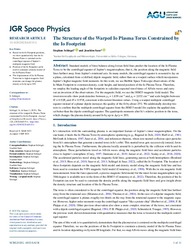The Structure of the Warped Io Plasma Torus Constrained by the Io Footprint
Persistent URL: http://resolver.sub.uni-goettingen.de/purl?gldocs-11858/11139
 |
Dokument öffnen: |
Standard models of force balance along Jovian field lines predict the location of the Io Plasma Torus to be the centrifugal equator of Jupiter’s magnetosphere, that is, the position along the magnetic field lines farthest away from Jupiter’s rotational axis. In many models, the centrifugal equator is assumed to lay on a plane, calculated from a (shifted) dipole magnetic field, rather than on a warped surface which incorporates Jupiter’s higher magnetic field moments. In this work, we use Hubble Space Telescope observations of the Io Main Footprint to constrain density, scale height, and lateral position of the Io Plasma Torus. Therefore, we employ the leading angle of the footprints to calculate expected travel times of Alfvén waves and carry out an inversion of the observations. For the magnetic field, we use the JRM33 magnetic field model. The inversion results show peak densities between
Based on the Io Footprint positions, we show quantitatively that the Io Plasma Torus is centered on the centrifugal equator of Jupiter’s multipole magnetic field
Position of the Io Footprint can be used to constrain a density model of the Io Plasma Torus
The displacement of the Io Plasma Torus due to higher magnetic field moments can change the plasma density at Io by up to 20%

